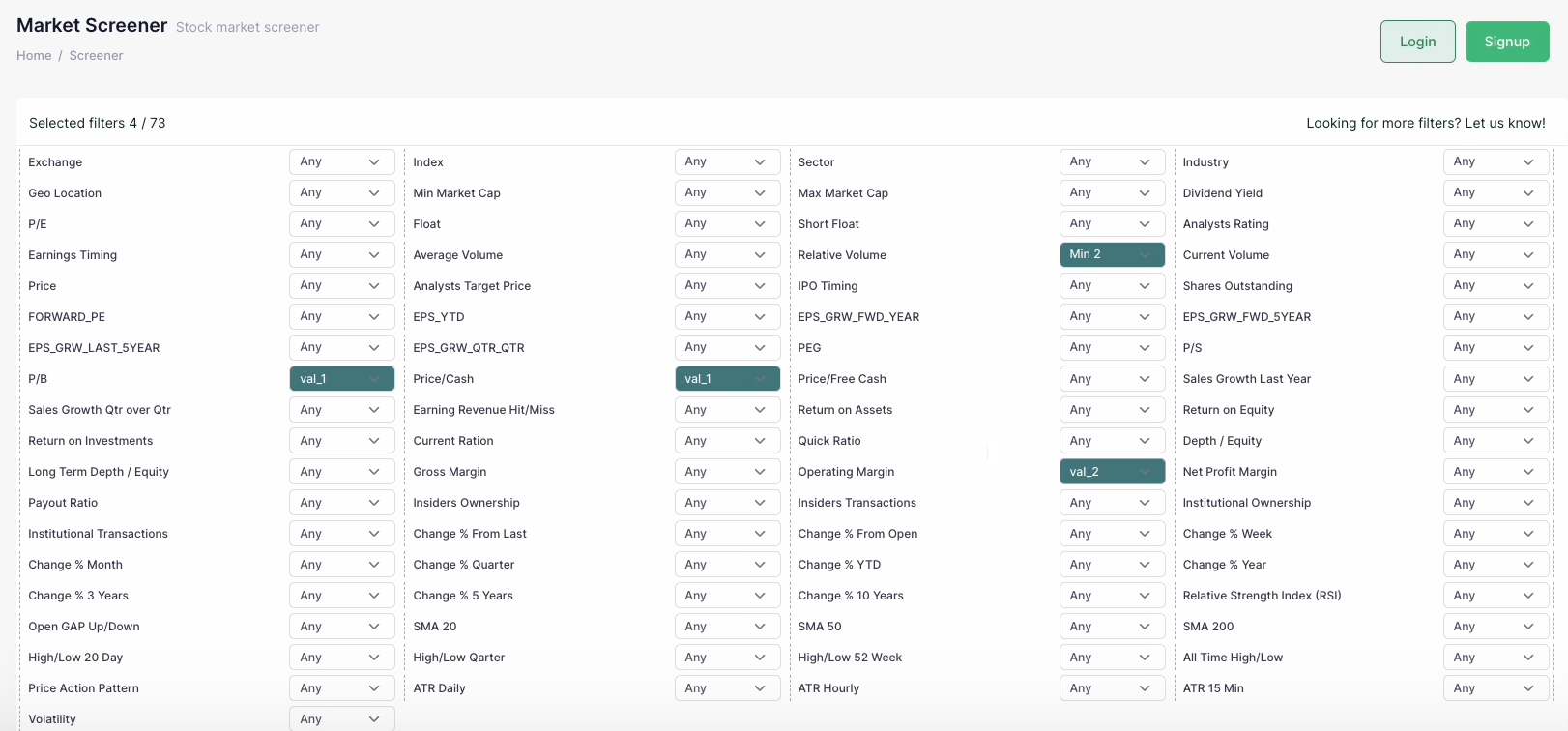Stock Screeners: What are they and how and Why to use them

If you're standing in a giant library with thousands of books on different companies, each representing a potential investment opportunity. Sifting through every book to find the ones that interest you would be incredibly time-consuming. This is where stock screeners come in.
A stock screener is a powerful tool that acts like a search engine for the stock market.
With a vast amount of publicly traded companies around the world, manually researching each one to find suitable investments can be overwhelming. Stock screeners are the solution to this problem.
What is a stock screener?
A stock screener is a valuable tool that empowers investors to sort quickly through a vast amount of stock data. These filters can be based on various criteria, allowing you to identify companies that align with your investment goals and risk tolerance.
What does a Stock Screener look like?
When you first encounter a stock screener, you might be overwhelmed by the sheer number of options and data points available.
For example,
Let's have a look at the AfterPullback Screener Page

Did you notice, there can be dozens of categories to explore, encompassing both technical analysis (focusing on short-term price movements and chart patterns) and fundamental analysis (focusing on a company's long-term financial health and prospects).
So, how to use all of this information?
The fact of the matter is,
You don’t need to use all of this information
Why?
Because the decision of which filter to use is dependent on your investment goals and risk tolerance:
If your focus is on short-term opportunities,
you'll likely be drawn to the technical analysis tools offered by many screeners like Charting which Visualize price movements and identify potential trading signals. Or,
You may be interested in Alerts. receive notifications when a stock price reaches a specific level or a technical indicator triggers a buy/sell signal (2e.g., RSI entering overbought/oversold territory). Or,
You may also like to use some Momentum Studies in which you analyze the speed and direction of price movements to identify potential trends.
On the other hand,
If you're a long-term investor focused on building wealth over time,
you'll find value in the fundamental data provided by screeners. This data can help you evaluate a company's financial health and growth potential,
Data like Earnings per Share (EPS) which measures of a company's profitability or Average Daily Volume showing the Liquidity of the stock, indicating how easily it can be bought or sold.
Similarly,
Filters like Market Capitalization using The total market value of a company's outstanding shares or the Financial Ratios can also be used by Long Term Investors. Metrics like P/E ratio, debt-to-equity ratio, and return on investment (ROI) can provide valuable insights into a company's financial health and valuation.
How Do Stock Screeners Work?
Alright,
So , all seems fine with stock screeners but
How do they work actually?
See,
The System of Screeners works in three parts;
The first one is a Strong Database
At the core of a stock screener lies a comprehensive database of corporations and companies. This database houses a wealth of information about each company, including financial data, industry sector, and stock price history.
Second Part is the Filters
Professional Traders use these filters a lot, individually as well as in combination
What Stock Screeners do is, to offer a customizable search experience through a variety of variables, or filters. These filters can be based on Fundamental Analysis Or Technical Analysis.
And the Last Part is the Screening Engine
Once you've selected your desired variables and set your criteria in your screener, the screener's powerful engine goes to work. It sifts through the vast database and generates a list of companies that meet all your specified conditions. This filtered list presents a more manageable set of potential investments compared to the overwhelming number of available options.
How to Use Stock Screener for Short term trading?
Using a Stock Screener for Short Term trading is a simple step-by-step process. The Process below will give you a basic idea, However, if you want to learn some advanced screening techniques, head on to our blog How to Use Stock Screeners for Advanced Screening Techniques
The process begins by identifying your Trading style
Are you a day trader, Swing Trader or a Scalper? You have to decide!
Day traders buy and sell within the same trading day, focusing on capturing intraday price movements. While Swing traders hold stocks for a few days to a few weeks, aiming to profit from short-term trends. Also, Scalpers make numerous trades throughout the day, profiting from tiny price changes.
Next, you have to decide which analysis approach suits you better Technical or fundamental? Experienced traders use both for the confirmation of signals.
Once the Analysis approach is decided then begins the real work
Here you Apply Screener Filters
Here you choose to apply some Basic filters like
· Exchange: Narrow down to exchanges you're familiar with (e.g., NYSE, NASDAQ).
· Price range: Set a range that aligns with your capital and risk tolerance (e.g., $10-$50).
· Market cap (liquidity): Choose stocks with sufficient trading volume . This will ensure that your screener not only spot the entry points but the exit points are also covered by screener (avoid penny stocks with low liquidity).
Along with the basic filters, you can also apply some technical indicators based on your chosen strategy. Here, you can choose some filter like
· Moving averages: Identify trends and potential support/resistance levels.
· RSI (Relative Strength Index): Gauge if a stock is overbought (high RSI) or oversold (low RSI), indicating potential reversal points.
· MACD (Moving Average Convergence Divergence): Identify trend strength and potential turning points.
As discussed above, along with the technical analysis, you can also add some Fundamental analysis filters.
Here you look for companies with strong fundamentals for short-term momentum.
· P/E ratio: A lower P/E ratio might indicate a stock is undervalued and has room for price growth.
· Earnings growth: Companies with consistent or increasing earnings are generally viewed as more stable and potentially on an upward trajectory.
· Recent news: Positive news events can trigger short-term buying sprees, affecting stock price.
Ok,
So,
What are some Popular Stock Screeners in the market?
Many screeners offer basic functionalities for free, with paid subscriptions unlocking advanced features like real-time data, backtesting capabilities, or more in-depth analysis tools (More on Free Vs Premium Debate below)
If you are just starting out, You can try FinViz or Yahoo Finance. These have great functionality for beginners.
Another great option is AfterPullback own screener as well
Here is what the website says about it features
AfterPullback Stock Screener is a Powerful Stock Discovery tool with Advanced Filtering
The Screener empowers you to identify potential investment opportunities through a comprehensive filtering system. Here's what it offers:
Granular Search Criteria: Utilize over 50 filters to narrow down your search based on a
wide range of parameters. These parameters can include factors like:
· Exchange Listing (e.g., NYSE, NASDAQ)
· Geographic Location of Issuing Company
· Financial Ratios (e.g., P/E Ratio, EPS)
· Price Action Patterns (identified through technical analysis)
Saved Screeners: Save your customized filter combinations as reusable screeners
for future use. This allows you to efficiently revisit specific search criteria.
Watchlist Creation: Convert your screener results into a watchlist to easily track
stocks that meet your defined criteria.
Automated Alerts : Receive email notifications whenever new stocks match your
saved screener criteria, keeping you informed about potential investment
opportunities.”
But Whatever Screener you choose,
Remember
Choose a screener that aligns with your investment style and the type of data you find most valuable.
Free vs. Premium Stock Screeners, Which one is right for you?

As we discussed above, Free and premium stock screeners are both tools that help investors filter through a massive amount of stock data to find potential investments.
But which one to choose?
Arguments in favor of Free Stock Screeners
Cost-Effective: Free screeners are a great option for beginners or those on a budget. They allow you to explore the world of stock screening and basic research without any financial commitment.
Basic Functionality: Most free screeners offer fundamental filters like market capitalization, price range, and sector. You can also find some basic technical analysis tools on free platforms.
Easy to Use: Free screeners are often designed with a user-friendly interface, making them accessible even for those with limited investment experience.
Limited Profile Functionality: Many free versions offer a profile where you can save screening criteria, though the full functionality here may be limited (e.g., you might only be able to save a few searches or encounter limitations on how long they are stored).
Arguments against Free Stock Screeners
Limited Features: Free screeners typically have limitations on the number of filters you can use, the data available (may not be real-time), and the types of analysis tools offered.
Less Flexibility: You may not be able to customize your searches as extensively with free screeners compared to premium options.
Potential for Ads: Some free screeners are supported by advertising, which can clutter the interface and potentially distract you.
Arguments in favor of Premium Stock Screeners
Advanced Features: Premium screeners offer a wider range of filters, including more in-depth fundamental analysis metrics, advanced technical indicators, and historical data analysis tools.
Real-Time Data: Many premium screeners provide real-time stock quotes and market data, allowing you to react to market changes quickly.
Customization and Flexibility: Premium subscriptions often allow you to create custom filters, save screening preferences extensively, and receive personalized alerts based on your criteria.
Backtesting Capabilities: Some advanced screeners allow you to test your investment strategies using historical data (backtesting) to see how they might have performed in the past. (This can help you refine your approach)
In-Depth Analysis Tools: Premium screeners may offer additional analysis tools like charting functionalities, stock comparison tools, and portfolio analysis features.
Arguments against Premium Stock Screeners
Cost: Premium subscriptions come with a monthly or annual fee, which can add up over time.
Potential for Overanalysis: The sheer amount of data and features available on premium screeners can be overwhelming and lead to analysis paralysis if not used strategically.
So what's the Bottom Line? Free or Premium?
Bottom Line is,
A free stock screener sounds like a good fit for you if you're just starting out or on a budget. They offer basic tools to learn the ropes and do some research, without any cost or complex features to overwhelm you. However, if you need in-depth analysis, tons of filters, or real-time data, you might outgrow a free screener eventually.
If you're a serious investor who needs a powerful edge, a premium screener might be worth it. They offer advanced tools for deep analysis, real-time data for quick decisions, and customization options to tailor your searches exactly how you want them. However, the cost can add up, and there's a risk of getting bogged down in too much information if you're not careful.
Putting All of this into Practice
OK, to sum up all the information here, Let's explore how traders with different goals might leverage a stock screener with specific filters. ( At the same time you also have to be careful not to repeat the mistakes while using screeners which most traders make)
Growth Stock Investor:
- Filter 1: Market Cap - Large Cap (> $10 Billion)
- Filter 2: P/E Ratio - Above Average (e.g., > 20)
- Filter 3: Sales Growth - Strong Growth (e.g., > 20% YoY)
This trader is looking for established companies with high valuations relative to their earnings but are experiencing significant sales growth. This could indicate a company that the market expects to continue growing at a rapid pace.
Value Investor:
- Filter 1: P/E Ratio - Below Average (e.g., < 15)
- Filter 2: Price to Book Ratio (P/B) - Less than 1
- Filter 3: Dividend Yield - Above Average (e.g., > 3%)
This trader is looking for stocks that may be undervalued by the market. They are using a combination of P/E ratio and P/B ratio to identify stocks that are cheap relative to their earnings and book value. The dividend yield filter helps them find companies with a history of paying out dividends, which can be a source of income for the investor.
Day Trader:
- Filter 1: Average Daily Trading Volume - High (e.g., > 1 Million Shares)
- Filter 2: Relative Strength Index (RSI) - Oversold (e.g., < 30)
- Filter 3: Moving Average Crossover - Short-Term Above Long-Term (e.g., 50-Day Moving Average above 200-Day Moving Average)
This day trader is looking for stocks with high liquidity (indicated by high average daily trading volume) that might be oversold based on the RSI (a technical indicator that measures momentum). The moving average crossover filter helps them identify stocks where the short-term trend is turning upwards compared to the long-term trend, potentially indicating a buying opportunity for a short-term price increase.
Conclusion
Stock screeners are powerful tools that can streamline the stock selection process for investors of all experience levels. By leveraging a screener's filters and data analysis features, you can identify companies that align with your investment goals and risk tolerance.
Whether you're a beginner focused on cost-effectiveness or a seasoned investor seeking advanced functionalities, there's a stock screener to suit your needs. Remember to choose a screener that offers the data and features you find most valuable, and don't be afraid to experiment with different options to find the perfect fit for your investment journey.





